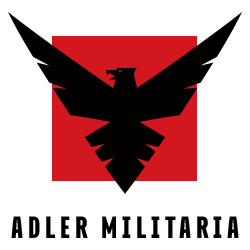Showing 1–9 of 1325 resultsSorted by latest
-

-
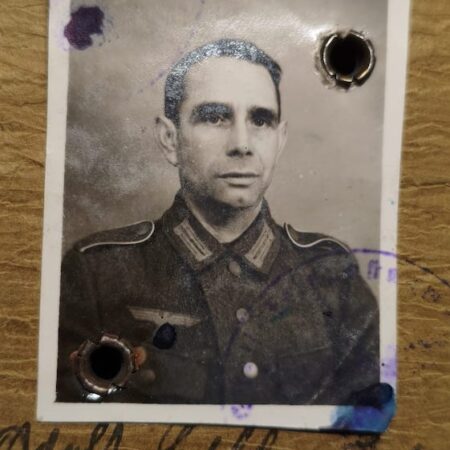
Original WWII German Wehrmacht – Soldbuch Gefr Adolf Edelkraut – Wounded in France July 1944 – 159 Reserve Division – Grenadier Regiment 74 – 19 VGD – Shot in Stomach – US 44th Infantry Division – Germany 1945
Soldbuch issued to Adolf Edelkraut born in Duisburg in 1907. Reserve Grenadier Batl 57 As part of the 159 Reserve Division they were stationed near Bordeaux France. On January 8, 1944, the division was deployed to southern France and deployed to protect the Atlantic coast. After the Allied landings in southern France, the division withdrew to Belfort, suffering heavy losses. Edelkraut was wounded with a Grenade Splinter (Soldbuch Code 31b) and delivered to hospital in Dax, France. Grenadier Regiment 74 – 19 Volks Grenadier Division In Early 1945, after healing he was deployed once again. January 3, 1945, the division was suffering heavy losses. The following weeks were characterized by hard fighting and hesitant resistance. On January 13, the division still had a combat strength of 1,500 to 2,000 men. After the costly retreat, the divisions of the XIII SS Army Corps were in the defense between Saarbrücken and Bitsch. No decisive fighting took place until the end of January 1945. Priority was given to the development of field positions and the reinforcement of the West Wall. On February 6, 1945, the US troops began a local attack against the right wing of the already severely weakened 19th Volksgrenadier Division. During these attacks, the US troops were able to capture the Blies Heights near the town of Saarguemines. The division was able to hold the remaining positions in front of the West Wall, but shrank to the strength of a weak divisional combat group. On March 15, the main attack by the American forces took place on a broad front against the West Wall. The defensive strength of the 19th Volksgrenadier Division declined rapidly, and the division was thrown back to the West Wall. On March 19, the division received orders to disengage from the front line with the remaining remnants and return to the Kaiserslautern area. In the following days, the remnants of the division were again dispersed. On March 24, it still had a strength of 400 men. On March 26, 1945, the division was officially disbanded. All that remained was the division headquarters. The remaining elements were combined into a combat group and assigned to the 2nd Mountain Division. At the beginning of April 1945, the remnants of the combat group were south of Dörzbach on the Jagst River. On April 21, the remnants of the combat group withdrew from the Crailsheim area toward Dinkelsbühl. From here, they continued toward Gingen an der Brenz. Here, their trail ends. More info: As the Allied counter-offensive against Operation Nordwind gained ground they were pushed by the US 44th Infantry Division. They fought alongside in February, then absorbed in March, the 340. Volksgrenadierdivision. The division was disbanded on 26 March 1945 in Waldangelloch, Bavaria, Germany and units were parcelled out to reinforce other units. It seems he was captured by US Forces, was badly wounded with a bullet wound in the stomach. He was quarantined due to the fact he had Typhus, and another bout of Malaria which he already had in 1943. As well as a back injury. He was released in the summer of 1946 and told to return home according to the Doctors Papers. His brother was killed in Normandy in 1944 – Wilhelm Edelkraut.
-
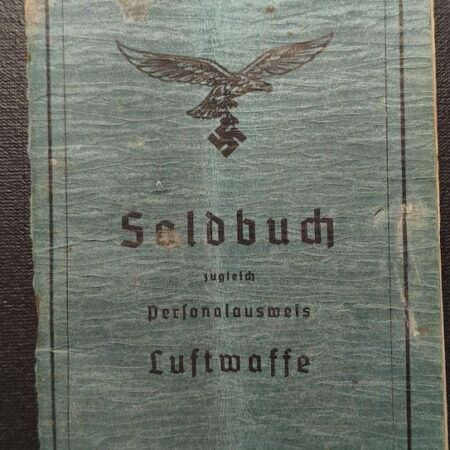
Original WWII German Luftwaffe Soldbuch – Kanonier Heinrich Helmecke – Flak-Ersatz-Abteilung 12 – Berlin 1945
Soldbuch issued in August 1943 to Kanonier Heinrich Helmecke. He was serving with – Schwere Flak Ersatz Abtlg 36 In 1944 his unit was stationed in Berlin: Schwere / Flak-Ersatz-Abteilung 12 1941/42 converted to schwere Flak-Ersatz-Abteilung 12. In 6.42 divided into: Flak-Ersatz-Abteilung 12 in Berlin-Lankwitz Flak-Ausbildungs-Abteilung 12 in Berlin-Lankwitz Service: 8.39 – 9.40 in Berlin-Lankwitz under Luftgau-Kommando III 9.40 – 8.41 in Berlin-Lankwitz under Kommandeur der Flakersatzabteilungen beim Luftgau III 8.41 – 5.45 in Berlin-Lankwitz It would seem this Soldbuch was outside for sometime, is it that he was KIA or Lost it? I was unable to find any definitive answer to this.
-
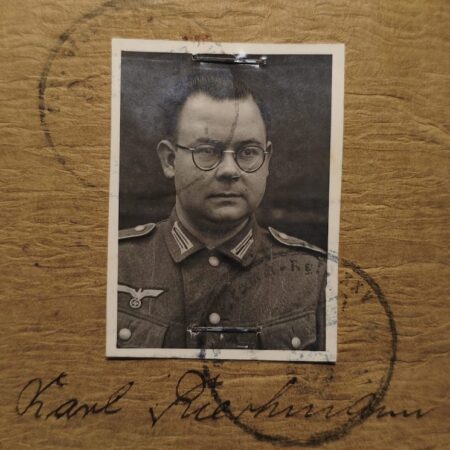
Original WWII German Wehrmacht Soldbuch – Obergefr Riechmann – Festung Lorient – Festung Lorient – Bataillon Böck – RARE!
Soldbuch opened in 1942 to Karl Reichmann. Served in the following frontline units: Reserve-Grenadier-Bataillon 467 Reserve-Grenadier-Bataillon 497 Reserve-Grenadier-Bataillon 487 Grenadier Regiment 535 On February 17, 1943, the reorganization of the regiment began within the 15th Army in France. The first units of the new regiment were assembled in the St. Omer area. After only eight weeks, the already formed elements of the regiment were relocated to the Atlantic coast of Brittany, to the area between Carnac and Saint-Nazaire, to complete their formation and be deployed for coastal defense. Festungs Stamm Reserve Kompanie XXV After the Allied landings in Normandy (June 6, 1944), the corps, under Commanding General Wilhelm Fahrmbacher, fought against the VIII US Corps (under General Troy H. Middleton with the 83rd Infantry Division, 4th and 6th Armored Divisions) in the fortresses of St. Malo, Brest, Lorient, and St. Nazaire. During the Battle of Brittany, the main attack on the fortress of Brest was launched on August 25, 1944, by the 29th Infantry Division from the west, the 8th Infantry Division from the northeast, and the 2nd Infantry Division from the east. By mid-September 1944, the 265th and remnants of the 343rd, 2nd Parachute, and 266th Infantry Divisions were under its command. Finally, only the 265th Infantry Division remained subordinate to the XXV Corps Command in the fortress of Lorient. Festung Lorient – Bataillon Böck Lorient, on the Bay of Biscay, had been an important French naval base until June 1940. With the capture of the base in the same month by German troops (see France campaign), the town in succession got more and more of strategic importance for the German Navy. This concerned above all the submarine construction with its bunker buildings on the peninsula Kéroman. U-Baot Bunker Kéroman III in Lorient In August / September 1944, following the Allied invasion of Normandy, the port and town of Lorient were completely enclosed by US and British forces, with some 22,000 German soldiers. Adolf Hitler thereupon declared the city a fortress. During the eight-month siege, which ended with the surrender of the remaining German forces on May 10th, 1945, there were some fighting going on. Battalion Böck (referred to as “Boeck” in the book) participated as a fortress assault reserve on April 30th to May 1st, 1945, in the occupation of the islands of Houat and Haedic as part of a combined sea and land operation. Mentioned in the book: Black Flag: The Surrender of Germany’s U-Boat Forces on Land and at Sea The book by Fahrmbacher: “Lorient”, 2nd edition, Prinz Eugen Verlag Weissenburg: P. 107. “The Chief of Staff of the XXV General Command, Colonel i. Gen. St. Bader, was recalled by radio order to another position in the Reich( ……………….) The Chief’s duties were now assumed by the 1st General Staff Officer, Lieutenant Colonel i. G. von Raven, and he was replaced by a proven young Ostmark native, Captain Böck.” P. 120: (Surrender) “The commanding general went there, accompanied by Lieutenant Colonel i. G. Raven, Captain Böck, and Lieutenant i. R. Buck…” At the beginning of the encirclement of the fortress of Lorient (August 10, 1944), approximately 26,000-28,000 soldiers entered the fortress, but only a very small number of these were trained infantrymen (according to FMS B-731, only approximately 800 soldiers). In addition, there were soldiers or individuals who were only partially eligible for infantry use of auxiliary weapons (approximately 3,000 soldiers for grenade launchers, anti-tank guns, 2cm anti-aircraft guns, etc.). Thus, initially, only approximately 3,800 soldiers were available for planned infantry training and further education who were even eligible for infantry use. Over time, other encircled members of the Wehrmacht, the Todt Organization, etc., were found who were ultimately trained and deployed as infantry personnel: 1,100 soldiers of the Marine Flak Artillery, 2,050 soldiers of the Marine Aircraft Personnel (including Battalion Böck, Marine Artillery Detachments 681, 683, and 688), 1,200 soldiers of the Air Force, 600 soldiers of the Signal Corps, Supply and Order Services, and the Supply Corps, as well as 1,200 members of the shipyard. Thus, a total of almost 7,000 soldiers were gathered (plus the 800 previous infantrymen), who were ultimately trained and deployed in a more or less infantry-like manner. The personnel target calculated for this, a minimal defense (need for infantry), was again, due to the circumstances (priorities, length of the front, etc.), at approximately 10,000 soldiers. Weapons K98K
-
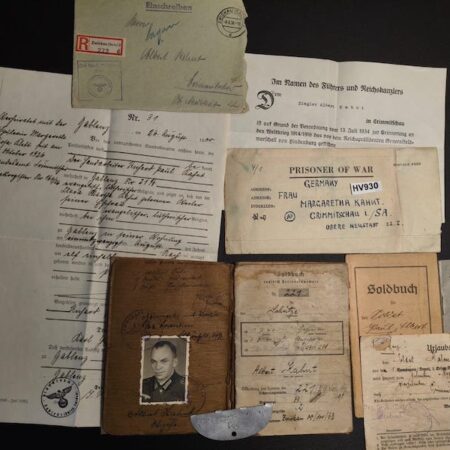
Original WWII German Soldbuch Grouping & EKM- Obgefr Albert Kahut – Captured in Normandy 1944 – POW in Cherbourg – Letter Translated – Rare
$355.00Soldbuch issued to Albert Kahut borin on the 21.8.1900 in Gablenz, Grimmitschau. Issued in February 1940. He served in the following frontline units: Infanterie Regiment 515 Bau Batl Grimma Personal Einheit 22 B Bau Batl 22 Landeschutzen batl 387 Betriebstoffverwaltungskompanie – Belgian / Nordfrankreich Festungs St Res Kp bei O.B West Betriebstoff Verwaltungs Kompanie 698 Captured in Normandy in 1944, an entry on the back of the Soldbuch reads: Im amerik Gefangenlarger 24 auf Sealbiusne, Cherborg France 1945 In an American POW Camp Nr 24 Sealbiusne, Cherbourg France 1945. Weapons / Equipment Dutch Rifle ! Some sort of Rifle made in 1917! Belgian Rifle. Medals Hindenburg Cross – 1935 Included are his WWI Shooting Book, and his WWI Soldbuch front cover.It seems he was for a short time in the Imperial Army in 1918 and there is a letter confirming he was with – Infanterie Regts Nr 105. Included is his Hindenburg Cross Certificate. POW Letter from him to his wife and kids… Translated 19 May 1945 – US POW CAMP France My dear Mutti and Dieter! As you, dear ones, can already see from the letter, I am in American captivity. Maybe you have received my red card. My dear ones, don’t worry about me, I am still doing very well, which of course I also wish for you, my dear ones. My dear Mutti, of course I can’t write to you every day; you must wait a little longer. Hopefully the war has not passed too hard for you and you are all still alive. Many warm greetings to all acquaintances. Until a healthy and soon reunion, best regards and kisses. For some reason his EKM is broken, it was for sure twisted off and is the bottom part. But I was unable to find any record of his death. Did he die a POW? Likely…
-

Original WWII Luftwaffe Soldbuch – Stabsintendant Otto Heine – Truppensonderdienst (TSD) – Kampfeinheit Tietze April 1945
$245.00HEINE, Otto. 01.02.45 Stabsintendant (RDA 01.08.33), on LPA Seniority List for TSD (V). He served with the Truppensonderdienst (TSD) On 25 Apr 1944, the Luftwaffe Special Troop Services was formed due to manpower shortages in the Luftwaffe. This branch was to be a compilation of Luftwaffe Officials with certain specialities who were brought into the Regular Luftwaffe and were give the status of regular Luftwaffe Officers. This was strictly a voluntary lateral move from the status of an Official to that of Regular Luftwaffe Officer. There were stipulations based upon speciality, age, and physical standards. Officials who did not choose to be a Regular Luftwaffe Officer or were not qualified for other reasons kept their status as Officials. By 01 Oct 1944, the transition was to be complete. The TSD was open only to officer rankings. There were two Branches of the TSD. These branches were Administration and Judicial. Insignia: The Officials traded in their administrative collar tabs and boards for the standard Luftwaffe types. Rank was reflected on the collar tabs by the use of the wreath and gulls. The double layered shoulder boards were removed and replaced by the boards with the single underlay. By April 1945 – he was assigned to Kampfeinheit Tietze – sadly I was unable to find anything for this unit.
-
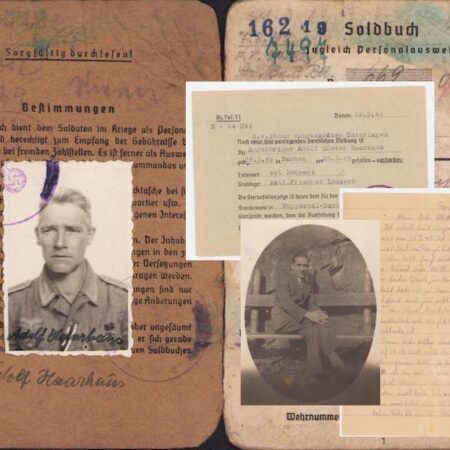
Original WWII German Soldbuch Grouping – Uffz Haarhaus – Heeres-Baupionier-Brigade 686 – Son Killed 1945 Kampfgruppe Becker – Sad last letters
Soldbuch Grouping to Family Haarhaus Soldbuch Issued on December 1939 – to Adolf Haarhaus from Wuppertal. Served in the following units on the frontline: Stellungsbau-Pionier-Bataillon 722 The Stellungsbau-Pionier-Bataillon 722 was established on 8 September 1943 at the Truppenübungsplatz Hammerstein, in Wehrkreis II. The battalion was raised as a Heerestruppe with 4 companies. After its formation, the battalion was transferred to the East. There, the battalion was deployed in southern Russia. On 30 May 1944, the battalion was renamed Baupionier-Bataillon 722. In the summer of 1944, the battalion served with Heeresgruppe A in northern Ukraine. In November 1944, the battalion, under Heeresgruppe A, formed the II. Bataillon of Heeres-Baupionier-Brigade 686. Heeres-Baupionier-Brigade 686 The Heeres-Baupionier-Brigade 686 was formed in July 1944. The brigade was established with Heeresgruppe A as a Heerestruppe. The staff of the brigade was formed from Pionier-Regimentsstab z.b.V. 686. In November 1944, the Bau-Pionier-Bataillone 402, 722, and 726 became the I. through III. Bataillon of the brigade. After its formation, the brigade was deployed in Galicia with Heeresgruppe A. Later, at the end of 1944, the brigade was employed in Poland. By the end of the war, the brigade was in action in Silesia. In January of 1945 he was sent to the hospital in Bad Tölz for a code 34 (Accident) likely to his foot given the hospital was specialised in Orthopaedic treatment. In 1945 he was with his replacement unit, Baupionier-Ersatz- und Ausbildungs-Bataillon 4 according to Tessin they were sent into action as, Bau-Pionier-Bataillon 4. Awarded the following medals: Eastern Front Medal in August 1942, Krim Shield 11.1943 under order of Generalfeldmarschall von Manstein. According to the documents along with the Soldbuch, it would seem he kept a diary of where he was in a leather pouch. Along with some letters, and his release papers from a POW camp in Berlin 1945. He was released and given the documents to return home. Although, it would seem his son was Missing in Action after the war ended for some time until declared as Killed in Action. See below for the letters and translations. Son – Panzer Grenadier Adolf Günther Haarhaus – Kampfgruppe Becker Letter to mother dated 8 March 1945 Raesfeld, 8.2.45 My dear Mother! I received your letter today; it was from 26.1.45. I was very happy to finally get mail from you again, since I have already been here in Raesfeld for five weeks. First of all, dear Mother, I want to give you my heartfelt thanks for your letter. I was especially pleased to hear that you and Father are still in good health. As for me, dear Mother, I am doing quite well, apart from a little homesickness, which is understandable. Otherwise, I am fine. Then, dear Mother, you wrote in your letter about whether I had received the Christmas parcel from Pfiff. Unfortunately, dear Mother, I have not received it yet, but maybe it will still arrive. Many thanks to Pfiff for sending it. I am just sorry that I cannot thank him directly. Your letter especially pleased me. Hopefully, I will soon receive another letter from you. Dear Mother, you asked whether I had already been in action. Yes, I already have. We were deployed once near Bochum in heavy combat and had to endure air raids there. I was also on a mission in the Ruhr area, where I experienced heavy bombing. But otherwise, everything is still bearable. The English and Americans are attacking us more and more, but our troops are still holding out bravely. How things will continue, we will see. Dear Mother, have you already received my soldier’s book? If so, please keep it carefully. Should I fall in service, it will be useful for the pension rights. Otherwise, dear Mother, I don’t know much more to write. Please don’t worry too much about me. I am always under God’s protection. Your loving son, Adolf Günter … Letter from Father requesting his sons death certificate. Herewith I request the service office to send me the death certificate of my son, the Panzer-Grenadier Adolf Günter Haarhaus, born on 14 May 1924 in Bremen. According to the notifications I have received, he fell as a result of a head injury. To provide confirmation of his death and of his burial in their records, the authorities are asking me to present the official death certificate. I therefore respectfully request that the Service Office issue and send me the death certificate of my son. As this matter is very urgent for me, I kindly ask for prompt handling and dispatch. I thank you in advance for your efforts and remain respectfully yours, hoping that I will soon be able to receive the requested certificate. —– Letter from Panzer-Grenadier Adolf Günter Haarhaus to his Mr Eck dated 21st Feb 1945 in Raesfeld. **Note this Letter was enclosed in the Feldpost, was later taken from his body and forwarded in 1948! ** See Below Dear Mr. Eck You probably did not expect to hear from me again. As you may have heard from the Diecaster, I was drafted into a new group. I am now with the … [text partly crossed out] Kampfgruppe Becker. How are you doing? Are you still with the staff? How is your work going? How are Schopft and Vollmer doing, and where are they? Is Winter still in the RAD? Well, Mr. Ehl, I will close for today and hope you will write me a few lines in return. I would be very happy about that. Many warm greetings to you, also to all comrades. … Letter from Mayor of Lembeck to Mr Eck Lembeck, 13 February 1946 To Mr. Fritz Eck c/o Fa. Grmeier Wuppertal-Barmen Früher Strasse der Alten Garde 99–103 On 23 March 1945, Panzergrenadier Adolf Günter Haarhaus fell here a hero’s death. On the body were found only a breast pouch containing 20 Reichsmarks, the identity disc, and the enclosed card. I must apologize that the card is only being forwarded to you today. The belongings of…
-
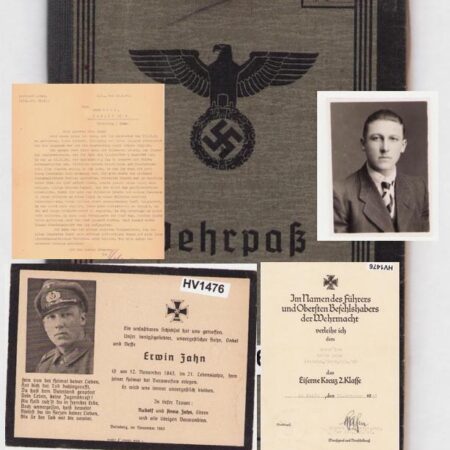
Original WWII German Wehrpass Grouping – Gefreiter Erwin Zahn – Grenadier Regiment 348 – 216 Infanterie Division – Iron Cross – Letters Fully Translated – Isle of Man Link! Rare
$365.00Sad grouping to Family Zahn. Wehrpass – Issued to Erwin Zahn – Born 1924 – Holder of HJ Sport Badge – did his RAD service in Graz – called up in December 1942 – joined his frontline unit in September 1943. Grenadier Regiment 348 – 216 Infanterie Division In July 1943, the 216th Infantry Division participated in the Battle of Kursk, where it sustained heavy casualties while fighting on the northern shoulder of the Kursk salient as part of Generalfeldmarschall Model’s Ninth Army. The division was disbanded on 17 November 1943 after suffering heavy casualties during the retreat to the Dnieper River Defensive Line. Zahns death card and Iron Cross Second Class Certificate, one spare photo in the back pouch as well as his death certificate. He will killed on the 12.11.1943 – the letter to his mother Anna reads: Lieutenant Leber,Field Post No. 21360 O.U., 14 April 1944 Mrs. Anna Zahn,Kowald No. 4,Voitsberg / Stmk. Dear Mrs. Zahn, Only today am I able to reply to your letter of 17.12.43. Due to operations, relocations, and my longer absence from the company, it was not possible for me to respond earlier. I spoke about your son with Sergeant Droste, the leader of the bicycle platoon to which your son belonged as a light machine gunner. On 12.11.43, the bicycle platoon was in reserve and carrying out entrenching work. Suddenly, enemy artillery fire began. A shell struck the pit in which your son and another comrade were working. Your son was fatally struck by multiple shell fragments. Sergeant Droste was in the immediate vicinity and ran to him at once, but he could provide no further help. A few hours later, after the enemy artillery fire subsided, your son was buried with Sergeant Droste and his comrades in a field grave on a hill in a small woodland west of Borschtschownka, a heavily destroyed small village. It was not possible to move your son further in order to bury him in a “heroes’ cemetery,” as the combat situation no longer allowed it. Since there was also no camera available, unfortunately no photographs of the grave could be taken. Soon after, this section of the front was abandoned. Your son was very popular with his immediate superiors and with all his comrades for his open, sincere nature and his always comradely conduct. It is with heavy hearts that we had to part from him! With best regards,Your [signature: Leber] The letter from the Doctor dated in 1945 relates to Annas Brother who was also Killed in Action. Dr. Bantz, Staff Doctor Deputy Chief Doctor Field Post Number: 36 77 0 O.U., 29 January 1945 Dear Mrs. Zahn, It is my sad duty to inform you that your dear brother, Oberjäger Peter Zeltmeister, died on 28.1.1945 after being admitted to our field hospital. Your brother had sustained a severe head wound with brain involvement. Death occurred during transport to the hospital. For more detailed information, I would kindly ask you to contact the last field unit of your brother. Please accept my sincere condolences on this grievous loss. Your dear brother made the ultimate sacrifice for the Fatherland and homeland in heavy fighting. His comrades will remember him as a good soldier, and I ask you also to preserve a worthy memory of him. The deceased will be laid to rest on 30.1.1945, in a dignified ceremony, alongside his comrades in a single grave at the soldiers’ cemetery in Csatkornya (Hungary). All personal belongings found with the deceased will be forwarded to you. Heil Hitler! Yours, [signature] Dr. Bantz Staff Doctor and Deputy Chief Doctor Interestingly two POW Letters are included and are from Annas Sister Hedwig, who for some reason was in an all female POW on the Isle of Man – the only such camp for females in WWII! Port Erin Women’s Detention Camp was a World War II internment camp on the Isle of Man at Port Erin. It was Europe’s only all-female internment camp. Notable internees included Dora Diamant, the lover of Franz Kafka in the last year of his life, and Fay Taylour, champion motorcycle, speedway and racing car driver. See more on the camp here: https://www.bbc.com/news/world-europe-isle-of-man-32810383 Translations: 26.4.1943 My dear sister Anna, Many thanks for your letter of 28.1.43, which unfortunately arrived so late that I could not reply sooner. Dear Anna, I believe this heavy burden is even harder for you and your family than it already is. Instead of resigning yourself to the inevitable and trying to make the best of it, you lament and cry and thereby suffer much more. But apparently that is the way of millions of mothers. They have to bear much heavier sorrows. But Anna, I am sorry, yet I do not blame you. On the one hand, you have a cheerful spirit that often helps you to bear much adversity. For you and others like you, only sorrow and pain come again and again. But you, with heart and soul, must stand by the Fatherland in this difficult time, whether or not you believe in it. Believe me, Anna, I have seen much among friends, and it is only about one Fatherland — one Germany — defending our cause. If sacrifices are demanded, then one day everything will be good again. With love for Hilda, my Fatherland. Your sister, H Another Letter translated: “AVEN HOLME.” G.H. Post Erin I.O.M. 26.4.1943 My dear sister Anna, Many thanks for your letter of 28.1.43, which unfortunately arrived so late. Dear Anna, I believe you and your loved ones are making life even harder for yourselves than it already is. Instead of accepting the inevitable and trying to make the best of it, you lament and weep, and in doing so you suffer much more. Yet it seems that this is the way of millions of mothers, who must bear even heavier sorrows. Anna, I am sorry, but I do not reproach you. On the one hand, you always keep a cheerful…
-
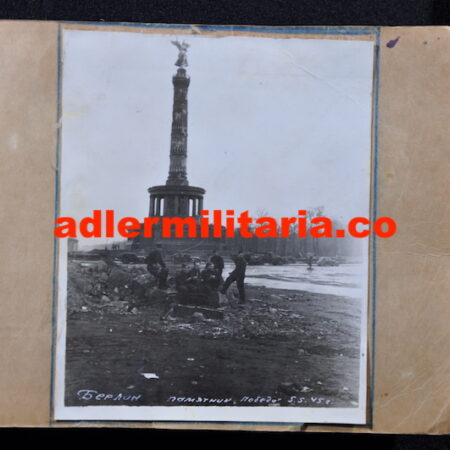
Original WWII Soviet Pilots Photo Albums – Epic Photos of Berlin in Ruins April 1945! – Ultra Rare
$975.00Here we have the photo albums of Soviet Pilot / Photographer : Ivan Ivanovich Puchko These images of Berlin in ruins are unpublished and extremely rare. Soviet Photoalbums for the Battle of Berlin are non existent, due to the lack of photo material in the Red Army for personal use. Any copying of the photos is strictly prohibited.
